Table of Contents

After the long vacation, when Ravi started going to school again, he noticed that the only playground next to his school was dug up. People said that a huge building with many flats will be constructed there. Ravi was almost in tears, when he realised that the big playground with its soft grass, marigolds and butterflies is gone for ever. He shared his feelings with his classmates. In the assembly, the Principal too sadly observed, “See how our environment is changing.”
In the class Ravi asked his teacher, “What is environment?” “Whatever you see in your surroundings,” said the teacher.
Ravi thought aloud, “That means, the school building, tables, chairs in the classroom, even that open field, the road, the garbage, my friends – all are parts of our environment”!
“Yes” said the teacher, “but wait….. Some objects are created by nature – for example, mountains, rivers, trees, animals. Others are made by people – for example roads, cars, clothes, books”.
Now work in pairs. Make a list with your classmate sitting next to you, of the creations of nature and by
human beings.
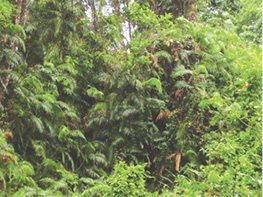
Environment is our basic life support system. It provides the air we breath, the water we drink, the food we eat and the land where we live.
How do human beings modify this natural environment? The car fumes pollute the air, water is collected in a pot, food is served in vessels and land is used to build factories.
Human beings make cars, mills, factories and manufacture containers. This is how human beings modify natural environment.
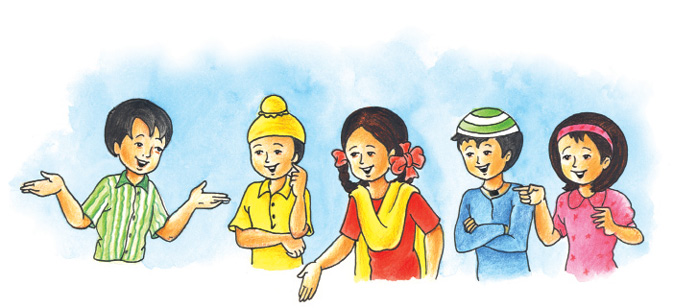
Ravi, Paramjeet, Jessy, Mustafa, Asha were all excited about making the list. “Why is our environment changing?” asked Iqbal. “It’s all because of our needs. They are increasing day by day; we are therefore modifying and at times even destroying our natural surroundings”, the teacher replied.
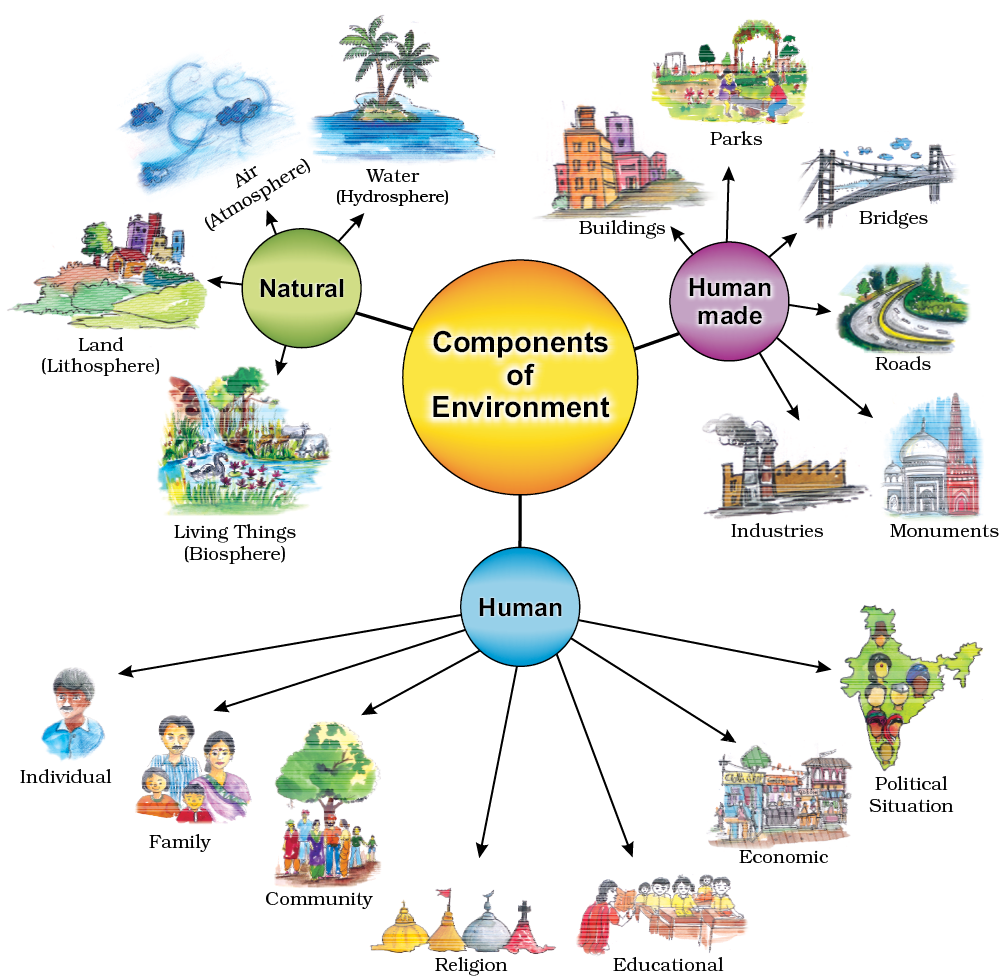
Fig. 1.1: Components of Environment
From the above conversation you understand that the place, people, things and nature that surround any living organism is called environment. It is a combination of natural and human made phenomena. While the natural environment refers to both biotic and abiotic conditions existing on the earth, human environment reveals the activities, creations and interactions among human beings.
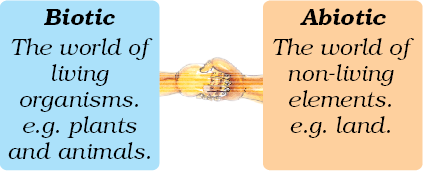
Natural Environment
Land, water, air, plants and animals comprise the natural environment. You are familiar with the meaning of lithosphere, hydrosphere, atmosphere and biosphere from your previous class. Let us learn some more facts about these domains.
Environment: French word Environer/Environner meaning “neighbourhood”.
Let' s do
Look at your surroundings. Make a list of uses that the land in your neighbourhood is being put to.
Lithosphere is the solid crust or the hard top layer of the earth. It is made up of rocks and minerals and covered by a thin layer of soil. It is an irregular surface with various landforms such as mountains, plateaus, plains, valleys, etc. Landforms are found over the continents and also on the ocean floors.
Lithosphere is the domain that provides us forests, grasslands for grazing, land for agriculture and human settlements. It is also a source of mineral wealth.
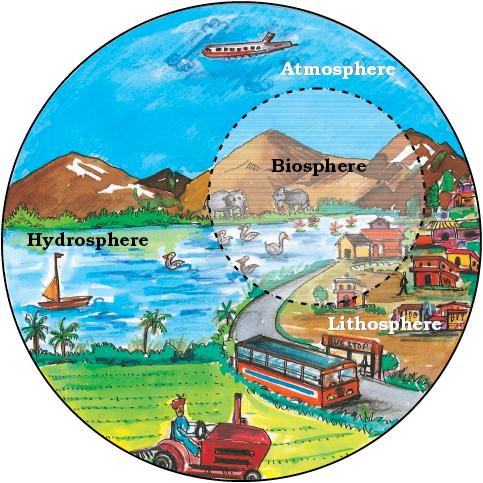
Fig. 1.2: Domains of the Environment
The domain of water is referred to as hydrosphere. It comprises various sources of water and different types of water bodies like rivers, lakes, seas, oceans, etc. It is essential for all living organisms.
Let's do
Where does the water you use in your home and school come from? Make a list of different uses of water in our daily life. Have you seen anyone wasting water? How?
Let's do
Observe the sky while coming to school. Make a note whether the day is cloudy, rainy, sunny, foggy etc.
The atmosphere is the thin layer of air that surrounds the earth. The gravitational force of the earth holds the atmosphere around it. It protects us from the harmful rays and scorching heat of the sun. It consists of a number of gases, dust and water vapour. The changes in the atmosphere produce changes in the weather and climate.
Plant and animal kingdom together make biosphere or the living world. It is a narrow zone of the earth where land, water and air interact with each other to support life.
What is ecosystem?
At an NCC camp that Ravi’s class was attending, Jessy exclaimed, “What a heavy downpour. It reminds me of my home in Kerala. You should come and see how it pours and pours and pours over the lush green fields and coconut plantations.”
Heera from Jaisalmer exclaimed, “We get no rains. We see only ‘kikar’ and sand, as far as the eyes can see.” “But you also find camels”, said Ravi.
Heera says, “Not just camels. If you visit our desert, you will see snakes, lizards and many insects too.”
Ravi wondered, “Why do the animals, the vegetation and the way people live vary from place to place? Are they all related to each other?”
“Oh yes, very much so”, the teacher replied.
Glossary
Glossary
Ecosystem: It is a system formed by the interaction of all living organisms with each other and with the physical and chemical factors of the environment in which they live, all linked by transfer of energy and material.
Let's do
Sketch or bring photographs of your place like the students in the story.
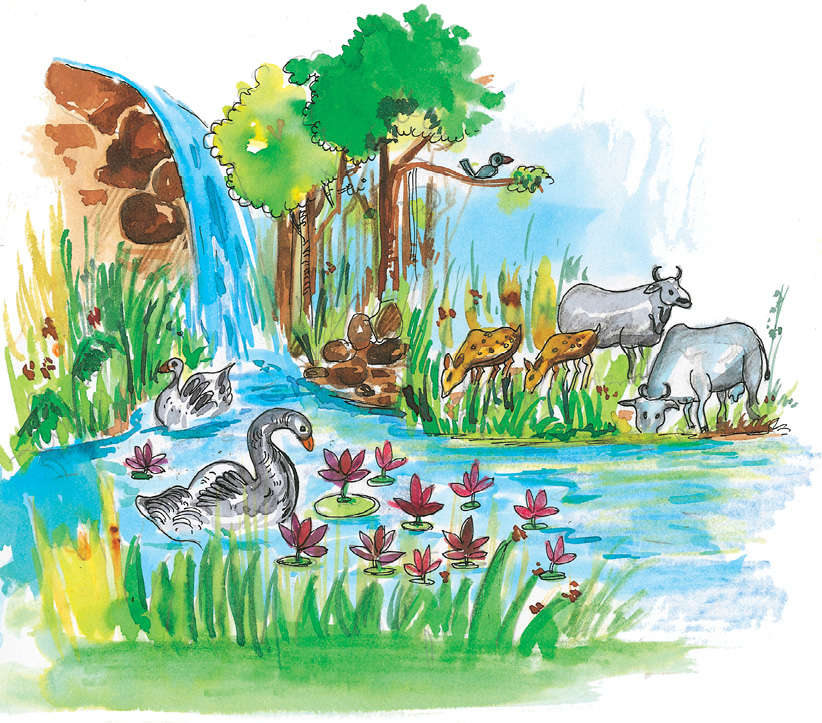
Fig. 1.3: A Pond Ecosystem
All plants, animals and human beings depend on their immediate surroundings. Often they are also interdependent on each other. This relation between the living organisms, as well as the relation between the organisms and their surroundings form an ecosystem. There could be an ecosystem of large rain forest, grassland, desert, mountains, lake, river, ocean and even a small pond.
Do you think the park in which Ravi and his friends played formed an ecosystem?
Do you know?
On 5 June every year the World Environment Day is celebrated.
Glossary
Barter System:
It is a trade in which goods are exchanged without the use of money.
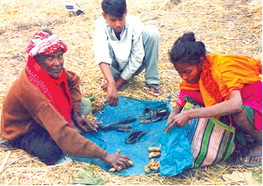
Let's do
Talk to some elderly person in your neighbourhood and collect information about–
• The trees in his/ her neighbourhood when he/ she was your age.
• The indoor games he/she played.
• His/her favourite fruit at your age.
• How did they make themselves comfortable during hot summers and cold winters?
Display your answers on a wall/bulletin board.
Human Environment
Human beings interact with the environment and modify it according to their need. Early humans adapted themselves to the natural surroundings. They led a simple life and fulfilled their requirements from the nature around them. With time needs grew and became more varied. Humans learn new ways to use and change environment. They learn to grow crops, domesticate animals and lead a settled life. The wheel was invented, surplus food was produced, barter system emerged, trade started and commerce developed. Industrial revolution enabled large scale production. Transportation became faster. Information revolution made communication easier and speedy across the world.
Have you ever thought why you love eating a juicy watermelon in summer and hot roasted peanuts in winter? A perfect balance is necessary between the natural and human environment. Humans must learn to live and use their environment in a harmonious way.
Nurie, a girl from Mizoram from Ravi’s class often talks about the lush green surroundings of her place. Seeing Ravi upset at having lost his playground, Nurie invited him to visit her home state during the coming vacation. Ravi’s teacher asked the students to draw the landscape, houses and activities of the people and places they visit during the holidays.

1. Answer the following questions.
(i) What is an ecosystem?
(ii) What do you mean by natural environment?
(iii) Which are the major components of the environment?
(iv) Give four examples of human made environment.
(v) What is lithosphere?
(vi) Which are the two major components of biotic environment?
(vii) What is biosphere?
2. Tick the correct answer.
(i) Which is not a natural ecosystem?
(a) Desert (b) Aquarium (c) Forest
(ii) Which is not a component of human environment?
(a) Land (b) Religion (c) Community
(iii) Which is a human made environment?
(a) Mountain (b) Sea (c) Road
(iv) Which is a threat to environment?
(a) Growing plant
(b) Growing population
(c) Growing crops
3. Match the following.
(i) Biosphere (a) blanket of air which surrounds the earth
(ii) Atmosphere (b) domain of water
(iii) Hydrosphere (c) gravitational force of the earth
(iv) Environment (d) our surroundings
(e) narrow zone where land water and air interact
(f) relation between the organisms and their surroundings
4. Give reasons.
(i) Man modifies his environment
(ii) Plants and animals depend on each other
5. Activity.
Imagine an ideal environment where you would love to live. Draw the picture of your ideal environment.

